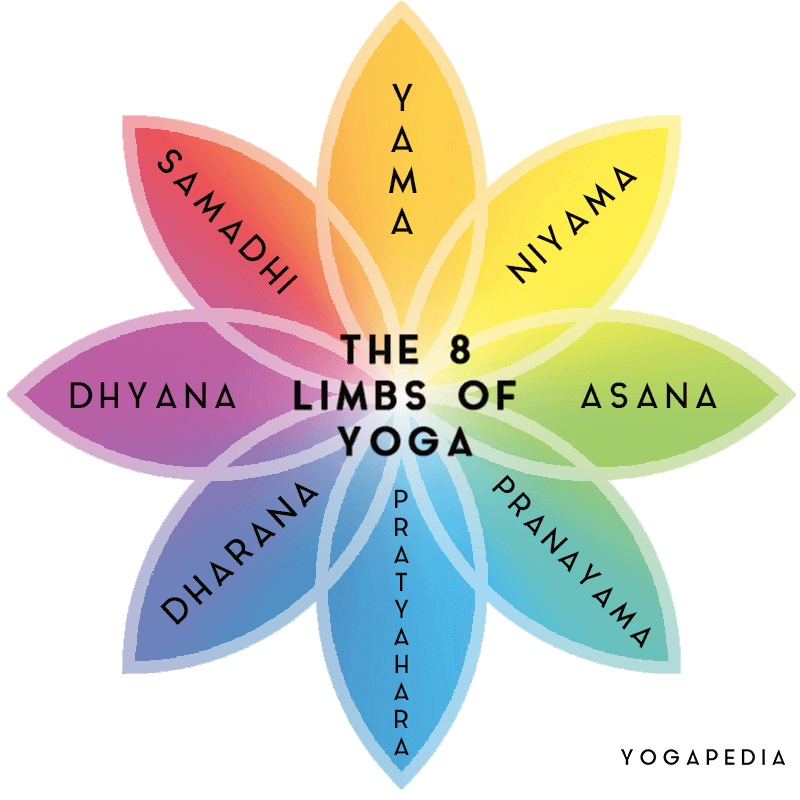The very first step on the eight-limbed path begins with setting rules for daily living. Known as the yamas in Sanskrit, the word itself translates to “restraint”.
The yamas themselves exist beyond time and space as universal applications practiced by everyone, no matter the gender, race, or religion. They promote living as a way of peace rather than suffering.

The word restraint may sound unpleasant as it indicates a sense of control to live a humane life and at times, we resist control. However, without structure in our ethical life, there will be no form not only for our personal lives but also in society. This can help not only our relationship with ourselves, but also our relationships with others while defining our moral character.
The concept of the yamas was expounded upon by the sage Patanjali in the second chapter of the Yoga Sutras, which outlines the system of ashtanga, or the eight steps to reach samadhi (enlightenment).
This first step of yama comes before the practice of asana, or physical postures, which means the practice of yoga begins with an inward-directed focus of control. This gives a certain depth and breadth to life beyond just the mundane, externally manifested world. It allows each person to have an inner experience of their interaction with the world around them.
The yamas of Patanjali are further broken down into 5 rules:
- Ahimsa – Nonviolence
- Satya – Truthfulness
- Asteya – Non-stealing
- Brahmacharya – Conscious Energy
- Aparigraha – Non-greed

Ahimsa
Ahimsa is the root from which the yamas originate. Its meaning touches all aspects of morality- that is the quality of nonviolence. It means “to not hurt” and when enforced, the quality of compassion arises in one’s life.
When you live by ahimsa, you agree not to harm yourself or others. This means in all ways– physically, by speech, and also by thought.
You can view your actions, words and even your own self-talk through the lens of ahimsa to develop compassion. For some, they may choose to eat a vegetarian diet, while others will fight for the rights of people who may be suffering.
The act of nonviolence was made famous by Mahatma Gandhi, the Indian political activist who helped gain India’s independence. However, as it is a universal quality, you can also see its use in history by other activists, like Nelson Mandela and Rosa Parks.
Read: Ahimsa: The Number One Yama of the First Limb of Yoga
Satya
The concept of truthfulness is embodied in the second yama, satya. It further expands upon the concept of doing no harm, because not telling the truth would be harmful. The word itself bears a similarity to the guna, sattva, which means harmony. Being truthful means living in harmony.
Yoga Sutra 2.36 says:
“When one is firmly established in speaking truth, the fruits of action become subservient to him.”
This quote in particular is tied to the law of karma, which means to act for the sake of acting, not for the expectation of a reward. When you live in your truth, by your deeds, words, and pure thoughts, you are not attached to any results but simply in the fairness of the universe.
There may be situations that arise where it is unclear whether to speak the truth for the sake of hurting another. In this case, it is best to refrain from harming unless specifically asked.
Read: The 5 Yamas According to Patanjali
Asteya
Asteya is the concept of not stealing. It refers to taking something from another that is not a part of yourself. Not only is this referring to the physical realm, but also to stealing another’s drafts, material, or information, such as is the case of plagiarism.
When someone steals from another, it can arise from a lack of compassion not only for the other but also for themselves. Without kindness in the heart, one may feel they are missing something and begin to envy or crave what another has so they can fill that gap in themselves. Unfortunately, this only leads to more suffering.
Stealing inhibits your own ability to grow intellectually or attain realization on how you may gain what you want yourself instead of by taking away from another. The Yoga Sutras indicate that asteya has its roots in the qualities of greed, anger, and material delusion, which causes a misappropriation of resources.
Read: The First Step of Yoga: Yama
Brahmacharya
The topic of brahmacharya can be a difficult one to navigate for many yogis and will require some personal exploration. When you break down the Sanskrit word itself, it means “walking with brahman”. The brahman can be thought of as the universal reality or divine, depending on your perspective.
Some have directed its meaning to complete Godliness, therefore requiring a strict path of celibacy. Others, still in association with its divine connotation, associate it with how one may direct their life force energy so that it is not wasted or depleted. This may be in how much sleep you get, how much activity you practice, or your relationship to sex. Brahmacharya asks you, how do you spend your energy in daily life?
Read: Yama and Niyama: The Yogi's Moral Guiding Lights
Aparigraha
The final yama, aparigraha, denotes the non-receival of gifts from others and living a non-possessive life. For example, if you receive something from someone, you may be obligated to repay them in the future, and you may not be in a position to return the favor, therefore suffering will arise.
Beyond this, aparigraha also refers to not accumulating excess materials in the physical world, because this will cause attachment. Its root is also in greed, which distracts you from your true nature of performing compassionate acts in the world.
“With constancy of aparigraha, a spiritual illumination of the how and why of motives and birth emerges.”
— Patanjali, Yoga Sutra 2.39
When you live in a state of aparigraha, you know the truth of yourself, how to remain unattached, and learn how to let go of what does not serve your highest good.
Read: Practicing Aparigraha (Non-Attachment)
Applying the Yamas to the Mat
When you step onto your yoga mat to practice asana, the mind does not stop. Even as you move, breathe, and hold different postures, the mind can help you focus, it can distract you, or worse, cause more suffering.
- Practice ahimsa by being compassionate with yourself and your body. Do not push yourself past your limits to the point of injury.
- Practice satya by being honest with yourself. Do you need an advanced variation or is your body begging for a child’s pose today?
- Practice asteya by not robbing yourself of time to actually step onto your mat, practice yoga, and increase peace in your life.
- Practice brahmacharya by directing your energy consciously toward your own evolution instead of activities that drain you.
- Practice aparigraha by congratulating those who may perform a difficult posture you are working on instead of wanting it for yourself. Turn your jealousy into excitement.
When you begin to consciously use the yamas Patanjali laid out for ethical living, you can awaken your own foundation for daily growth.
Each yama is like a different seed planted in fertile soil and you water them daily with your thoughts, words, and actions for the rest of the eight-limbed path to unfold toward more enlightened living.
During These Times of Stress and Uncertainty Your Doshas May Be Unbalanced.
To help you bring attention to your doshas and to identify what your predominant dosha is, we created the following quiz.
Try not to stress over every question, but simply answer based off your intuition. After all, you know yourself better than anyone else.